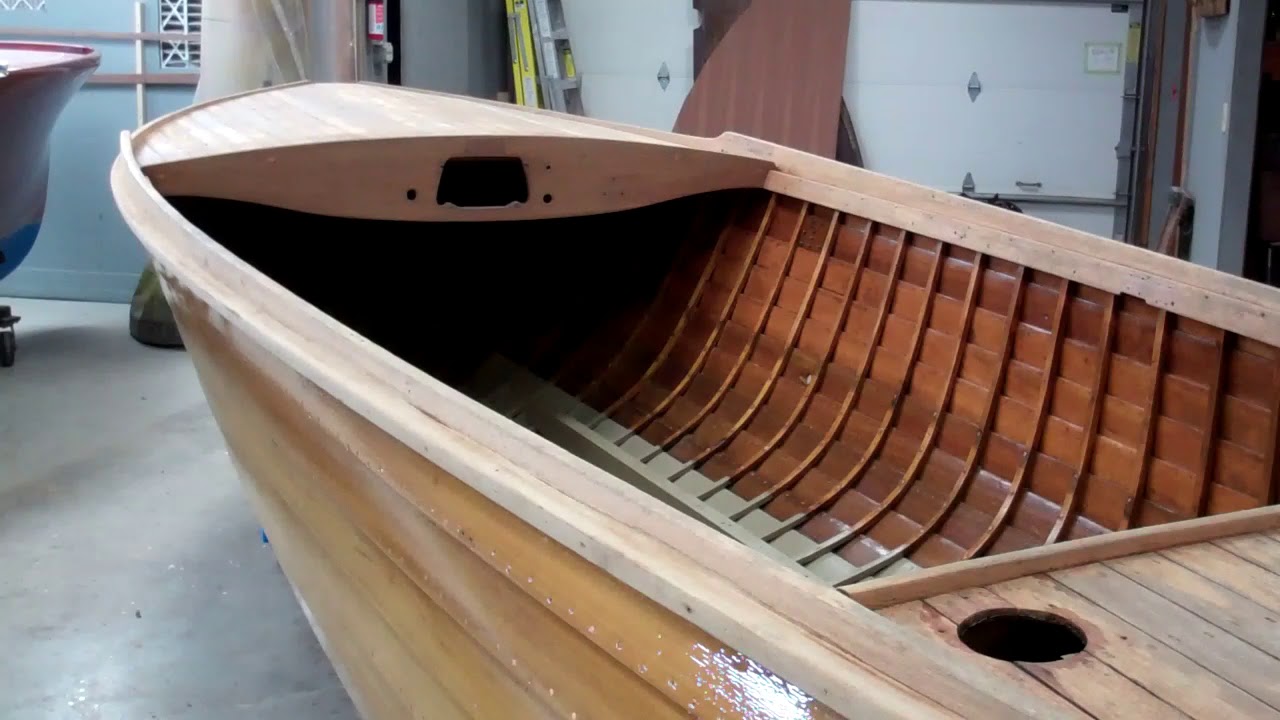Happy St. Patrick’s Day, on Saturday, March 17, 2018!
At the end of the day yesterday, John and RJ teased me with, “You might find a surprise when you come into the shop tomorrow morning.”
Right they were. We’ve shared several videos recently in which this Lyman was upside down. In fact we stained and sealed the topsides and transom, and John and RJ applied the initial eight coats of Pettit Easypoxy Hi-Build Varnish with her flipped. She has also been flipped while RJ and I stripped, sealed and finished her interior surfaces with a combination of Sikkens Cetol Marine Varnish, and Sandusky Lyman Sand Tan Bilge Paint.
They must have sneaked back to the shop last night. When I walked in this morning, there she was, upright and standing proudly on her boat dollies. What intriguing lines. And the combination of coamings and planked decks adds so much to her design.
Facing me now is stripping what is left of ancient varnish from her decks and coamings with a heat gun and BAHCO scraper, and cleaning her deck seams with a reefing hook. Yes, using Circa 1850 chemical stripper would likely be faster, but doing so risks dropping the stripper onto finished surfaces unless I protect all of them with masking paper, a task that would be both hugely tedious and terribly time consuming.
I have been searching for Lyman material and research that will help me nail down her model. Tossing the question out to the membership of the New England Lyman Group spawned a lively conversation and also a 1941 Lyman brochure that answered the question.
She meets all the criteria of the “15-foot Custom Inboard Yacht Tender.”
Here is an excerpt from that brochure:
The 15’ Yacht Tender has been the answer to many a yacht owner’s problem of procuring a practical tender, light in weight, fast and smart in appearance. It is being used on some of the finest yachts in the country today. Because the carrying space for a tender on many boats is limited, the Yacht Tender can be built on special order within the limits of 14’ to 16’. The steering wheel is mounted on a special bracket in the forward cockpit and the engine controls are handily located. The motor is installed admidship (SIC), fully enclosed and freely available. The seat in the other cockpit faces aft.
Susan satisfies the following criteria stipulated in the brochure:
- LOA – 14’ to 16’. Susan’s LOA is 15’8”.
- Beam – 5’4”. Check.
- Planking — edge grain cypress or Philippine mahogany. Susan’s topside strakes are edge grain cypress. She is planked with Philippine mahogany below the waterline.
- The outside of the hull is painted white or finished bright (varnished). Susan is varnished.
- Decking, seats, motor compartment and all other trim are of Philippine mahogany. Check.
- A spray shield, in place of the windshield (as shown above) is optional equipment at no additional cost. Susan is outfitted with an absolutely flat-across-the-deck spray shield.
We will now sand her topsides flat, followed by applying 3 – 5 additional coats and sanding again.
Some of the clench nail heads are seated beneath the fair surface, but these declivities will continue filling as additional coats are applied.
Our goal is an absolutely flat surface and varnish that allows all those brilliant copper clench nail heads to shine through.
Yes, we’ve set another milestone free and watching it fade into our wake!

